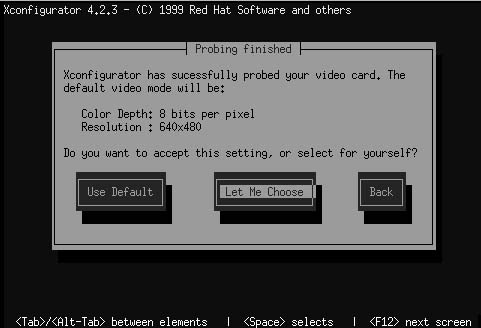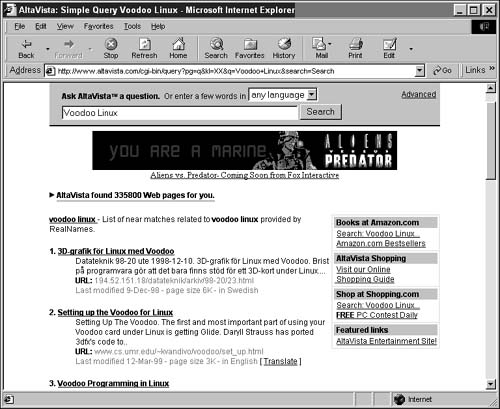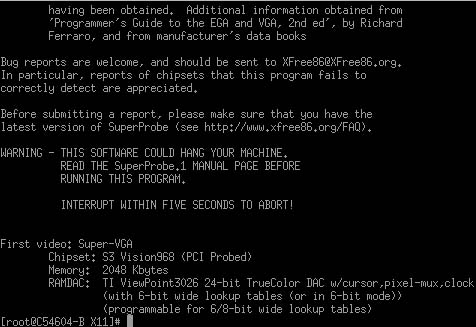Configuring your Video Card and Monitor
One of the biggest problems with Linux installations can be correctly configuring Linux for your video card and monitor. This is an issue because there are so many different video systems in use, and also because Linux is often installed on older hardware.
Figure 2.14. Use Xconfigurator to configure Linux to work with your video card and monitor.

You will be asked to configure your video system as part of the Linux installation process. However, the same video configuration process can be performed at your convenience from the Linux command prompt without rerunning the installation program. (For information on using the Linux command prompt, see Chapters 3 and 6.)
Figure 2.15. You should select your monitor if its on the list;otherwise, you can manually enter monitor settings by choosing Custom.

To use Xconfigurator
1. | At the Linux prompt, in either full-screen or terminal mode, type Xconfigurator. The video configuration program will start with an information screen (Figure 2.14). |
2. | Use the Tab key to highlight OK; then press Enter. The Choose a Card dialog box will open. |
3. | Use the arrow keys and spacebar to select your video card. If you cannot find your video card, Generic VGA is a reasonable choice. See the information on SuperProbe in the next section. You may also find it helpful to review the information inChapter 1 on obtaining information from Windows about your current hardware. |
4. | When you are satisfied with your choice, highlight OK and press Enter. |
5. | You will next be asked to enter your monitor type (Figure 2.15). If your monitor isnot listed, choose Custom to manually select refresh rates (described later) or choose a generic monitor type. |
6. | Depending on your type of video card, and whether it can respond to automated probes, you may be asked to specify the amount of RAM it has and the RAMDAC chipset used. |
7. | If you chose a custom monitor, you will be asked to enter its horizontal sync range Figure 2.16 Figure 2.16. If you are entering custom monitor settings, you must select a horizontal synorate
|
8. | Next, you will need to specify your monitor's vertical sync range (Figure 2.17). Figure 2.17. If you are entering custom monitor settings, you must select a vertical synorate
|
9. | Finally, you will be asked to accept a color depth resolution setting (Figure 2.18). If you do not like the default settings, select Let Me Choose to enter your preferred resolution and color depth. |
10. | When you are satisfied with your choices, click OK. Xconfigurator will turn your monitor off and on several times, and you will be asked to verify that video is still working by clicking Yes. |
11. | You will be asked whether you want Linux to automatically boot to X-Windows. If you have reasonable confidence in your choices of video card and monitor, choose Yes. |
Figure 2.18. If do you not like the default color depth and resolution settings selected by Xconfigurator, you can enter your own choices.

Tip
Note that the sequence of screens and options is the same whether this program is run from the command line or as part of the installation process.
Tip
Before running Xconfigurator, you can find some information about your video card by running SuperProbe (described later in this chapter).
Tip
If X-Windows (Gnome) is not set to start automatically, you can start it from the command prompt by typing startx and pressing Enter.
Tip
If all else fails, go to a Web search engine and type the name of your video card and the word Linux in the search box. You are likely to get good tips for dealing with your specific problems. (Figure 2.19 shows the results of a lookup for the Voodoo video card and Linux on Alta Vista.)
Figure 2.19. You can find information on configuring specific graphics hardware for Linux by using a Web search engine.

SuperProbe is used to find information about your video card. However, it is not perfect. Not only does it not always provide helpful information, but it also has been known to crash systems. However, if you can't find out about your video chipset in any other way, it is certainly worth a shot.
To run SuperProbe:
1. | Log on as root or su to root. |
2. | At the command prompt, type cd /usr/bin/x11 |
3. |
Figure 2.20. SuperProbe provides information about your graphics card.



